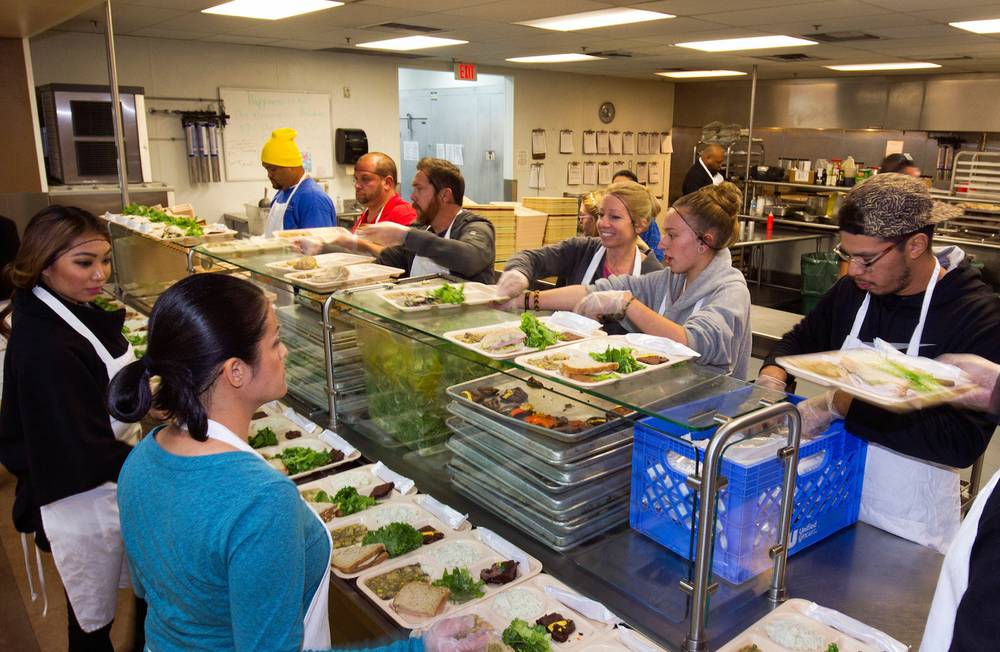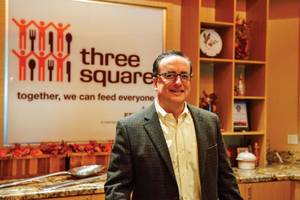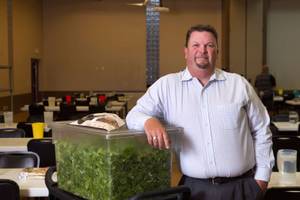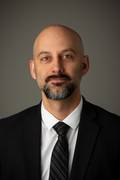Yes, there is beauty and there are the humiliated. Whatever may be the difficulties of the undertaking, I should like never to be unfaithful either to one or to the others. –Albert Camus
It doesn’t immediately make sense for Las Vegas to be hungry. Southern Nevada’s identity is wrapped up in the perception of Vegas, the glitz and the fun, a place to indulge and over-indulge. The real Las Vegas, though still dynamic, is plagued with the real problems of any growing American metropolis, and in some cases those problems are worse here.
Feeding America, the nation’s largest hunger-relief charity with a network of more than 200 food banks, conducts its signature study Map the Meal Gap every year, measuring the rate of food insecurity across the country. Food insecurity is often characterized as not knowing where your next meal is coming from, but the study defines it as the household-level economic and social condition of limited or uncertain access to adequate food. The most recent Map the Meal Gap estimates there are 49 million food-insecure people in the U.S., one in every six, including 16 million kids, one in every five.
Nevada has the fifth-highest rate of childhood food insecurity in the country, with some staggering numbers coming from Clark County—305,430 food-insecure people, nearly 16 percent of the population, and one in every four children. “I call it the paradox of Las Vegas, because you have some of the world’s most expensive retail and fine dining and lodging, and the best shows on Earth, and then just a mile or two away the contrast is stark,” says Brian Burton, president and CEO of Three Square food bank. “I think every American city has large numbers of working poor and homeless and people who are struggling under crushing conditions. Here, it’s just a little more pronounced because of the face that we show to the world.”
Founded in 2007 by Eric Hilton of the famous hotel family, Three Square has quickly and efficiently become much more than Southern Nevada’s only food bank and the region’s hub in the fight against hunger. It’s a national model for collaborative community partnership, working closely with dozens of businesses, nonprofits, food distributors, the school district, government entities and thousands of volunteers. Three Square provides more than 34 million pounds of food and grocery product—more than 28 million meals—per year to more than 1,300 community partners. It’s also the leading local organization researching the issue.
“What I love about this food bank is innovation,” says Burton, who came to Las Vegas five years ago from Dallas, where he supervised a smaller Methodist food bank. “We’ve been able to do a lot of practices bigger, better and smarter than a lot of other places, and we’ve imported a lot of business culture here. We are a nonprofit, but that doesn’t define us.”
That approach has sparked the organization’s rapid growth and guided its operations and partnerships. Three Square receives food through donations from individuals and organizations, and by collecting unused products from grocery stores and purchasing food from retailers, among other channels. Its hundreds of partners—churches, schools, shelters, community and senior centers—order and pick up food at the bank to distribute to those in need. Faith-based organizations make up the majority of distributors, and Three Square strives to direct volume to neighborhoods with the highest concentrations of at-risk populations, for example, in central and North Las Vegas and around the Valley’s eastern perimeter.
Touring its impressive North Las Vegas facilities and learning about how efforts like the Supplemental Nutrition Assistance Program—an outreach program allowing low-income families to purchase healthy foods, sometimes on the same day as applying for assistance—are bridging the gaps of local hunger, catching those slipping through the cracks, one could get the idea that Three Square is making a major difference against what seems an insurmountable problem. Burton says it will take 52 million pounds of food to solve the local meal gap; we’ll be at 40 million this year. He says we’re “nipping at the heels,” of local hunger and have the determination and resources to overtake it.
*****
But hunger is not a stand-alone issue. And recession-era factors that ballooned unemployment, expanded poverty and exposed a lack of support structures across the U.S. were highly concentrated in Southern Nevada. You can find proof of that, along with uplifting success stories, at any of the local organizations providing free meals to the homeless and the hungry.
John Fogal, director of development at Downtown’s 45-year-old Las Vegas Rescue Mission, measures success one story at a time. “One way is volume, the number of meals we’re able to provide,” he says. The mission built a new dining hall in 2009, skyrocketing the number of meals served each month from 12,000 to approximately 32,000. “But the other way is that inside those numbers, each one of those has a story of an individual striving for success.”
He tells the tale of a homeless woman who first came to the mission for a meal, then another, before she was eventually convinced to get off the streets and stay in the shelter for a week, which turned into a full stay in the mission’s addiction recovery program. Her initial unsociable ways—she never looked up, rarely spoke—were attributed to the damages caused to her teeth and mouth from methamphetamine use. After graduating from the recovery program, she began working at a local Walmart, returned to the mission to volunteer and was eventually promoted and transferred to a store in Florida—and became a public speaker sharing her own story at corporate gatherings.
With a staff of 43 and volunteers numbering around 1,300, the rescue mission, originally a tiny storefront on Bonanza Road making sandwiches for the homeless, has evolved into a one-stop shop, also offering emergency beds, a thrift store and a voucher program providing various necessities for the homeless transitioning into homes. A nonprofit fully dependent on donations, it’s truly a product of the community, more evidence that as big as this problem might be, Las Vegas’ generous heart seems up for the challenge.
“We definitely saw a surge in donations when the economy got tougher. All of a sudden it was closer to home,” Fogal says. “There were individuals down here in line who were probably making $90,000 a year two years earlier.”
A former pastor who has lived all across the country, Fogal has been in Las Vegas for six years and was initially surprised at how widespread the issues of food insecurity and homelessness are here—back to the paradox, the beautiful and the humiliated. “We do have that stereotype. But the flipside of that is most people don’t realize how generous and caring and giving this community is.” The mission wouldn’t exist if it wasn’t.
*****
Coming to terms with Las Vegas’ hunger can be difficult. A simple starting point: understanding and accepting that anyone can be hungry. Las Vegas might have less generational poverty than older cities, but only because it has had fewer generations—and as Burton points out, those groups develop a set of survival skills that includes knowledge of available resources like food banks and other mature institutions. We’re still building that network of resources.
Scary and continued growth in the number of food-insecure families points to high numbers of formerly middle-class people standing in the food lines. Looking at the 2015 map of Las Vegas food insecurity (produced by Dr. Craig Gundersen, Feeding America and Three Square, with help from Applied Analysis) can be a chilling experience. I bought a home this year, a nice place with a swimming pool in the suburbs, brushing up against the affluent master-planned community Summerlin. My 89117 zip code has an alarming food-insecurity rate of 17.1 percent, and it’s just one of many unpleasant surprises on the map. The Spaghetti Bowl area tallies a 27.5 percent rate. The allegedly blissful ’burbs register in the low teens.
We could get frustrated by the assumption that Las Vegas is still figuring out how to take care of itself. But we’ve always been late bloomers. “Where we are in our development is probably where a lot of other cities were 40 years ago,” Burton says. “Most of those cities had not figured out a lot of things in the ’70s that they’re doing well now. Will it take 40 years to catch up? I don’t think so. We have a whole different world, different technologies and information.” And people like him are working hard to take advantage of this new, different world to solve this oldest of problems.
Help for the holidays
Through the end of the year, donations made to Three Square Food Bank will be matched dollar-for-dollar by seven businesses as part of the sixth annual Holiday Match Challenge. Backing this year’s effort: Barrick Gold, Boyd Gaming, Crovetti Orthopaedics & Sports Medicine, IGT, L.L. Bradford CPAs, Towbin Automotive Group and UnitedHealthcare. A half-million dollars or more can be raised through this challenge for Three Square programs. Since its inception, the Holiday Match Campaign has raised nearly $2 million, or approximately six million meals for those in need in Las Vegas. If the holidays are the time we tend to give most, this is a great way to do it. Find out how at threesquare.org/how-to-help.







